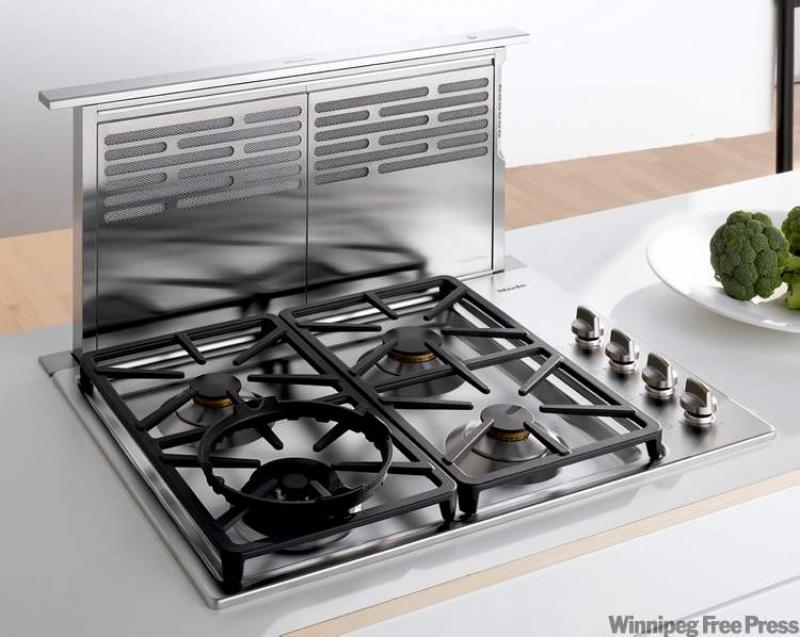

It's hard to reinvent the kitchen. Its core functions have pretty much stayed the same over the years.
It's a place to prepare food, whether you cook elaborate meals from scratch or do nothing more than microwave frozen entrees.
It's a place to store food, whether all you have is a carton of milk in the fridge or a pantry equipped with every conceivable spice, oil and gadget.
And it's a place to wash up, whether you simply rinse a coffee mug in the sink or spend 10 minutes programming a high-tech dishwasher.
But kitchens do evolve and the recent Interior Design Show in Toronto gave some insight into where they are heading.
The biggest mega-trend in kitchens is they are not walled off from the rest of the house. It's open concept all the way. And from this one idea, many others follow.
"As kitchens move more into the family area, from a design perspective there's a huge trend toward integrating them as seamlessly as possible into the cabinetry," says Kelly Lam, director of marketing for Miele Ltd., (www.miele.ca) the German-based maker of high-end appliances.
In other words, kitchens are increasingly being designed so appliances don't stand out.
"It doesn't matter how beautiful your appliances are, you want your space to be multi-use," says Horia Gruia, owner of Dekla Kitchens (www.dekla.ca), a dealer for Scavolini kitchens in Toronto, adding the idea of multiple uses for space is particularly important in the tiny condos being built in downtown areas.
A few years ago, kitchen creators started by camouflaging the appliances to match the cabinetry. Now, some are going one step further by physically hiding them.
Richard Cadoret of Toronto's Dom Showrooms (www.domtoronto.com), for example, was showing a kitchen by Valcucine, a high-end Italian company. The kitchen's upper cabinets could be completely hidden by a door that folded down from above. The backsplash area, which contained a lot of the kitchen's guts (plugs, racks and other utilitarian things) could be completely hidden by a panel that rose up from inside the counter. And the built-in stovetop could be camouflaged by a large wooden chopping board that rolled along the counter.
"The big news is all about open concept living in an elegant or stylish manner," says Cadoret, explaining you hide appliances and utilitarian things so the kitchen harmonizes with the rest of the living space.
To keep kitchens from looking like kitchens, knobs and pulls on kitchen cabinets are also disappearing.
"The modern kitchen is going toward no visible hardware," says Gruia. "That requires new technologies for opening and closing doors and drawers."
Several exhibitors, for example, were showing electrically operated kitchen doors and drawers. Touch the cabinet door and it swings open, usually by lifting up. Touch a button and it closes. One such system, called Servo-Drive, was being displayed by Blum, a kitchen hardware manufacturer (www.blum.com).
The promoters of these mechanisms admit if there's a power failure you may not be able to get at your plates and cups. For people who don't want to have to rely on electricity, there are often mechanical versions of the door-openers available.
Even kitchen fans are being hidden. Miele, for example, was showing a prototype fan that folds up into a glass panel when not in use. Another Miele fan, a model being launched in Canada this year, pops up vertically out of the counter when needed and pops back down when not wanted (it sits behind the stove, not above it).
Because kitchens are now open to the living spaces, they are being designed for entertainment functions. One new concept is "the entertainment sink" -- a second sink at some distance from the main one.
Novanni Stainless of Oakville (www.novanni.ca) was showing a long, shallow sink that kind of meandered. The model was appropriately called Mystic River. I couldn't imagine washing dishes in it. What was it for?
Novanni's John Pearce explained this kind of sink has two uses, both of which involve entertaining in an open concept space.
One is that you fill it with ice and keep bottles of wine, or maybe shucked oysters, chilling there.
The other involves putting guests to work.
"You know how when people come over they always say, 'Can we do anything?' Well, if you have a secondary preparation area, you can give them potatoes to peel."
Granite countertops are still big, and concrete too. But new materials -- particularly glass -- are finding their way into kitchens.
"We've started using glass cabinets more and more," says Gruia. "We're seeing frameless glass systems in matte finishes."
Cadoret showed off acid-etched, back-painted glass countertops. The acid etching, he explained, means fingerprints won't show.
And environmental concerns are now being addressed in design.
Garbage systems, said Gruia, are being designed for recycling. And kitchens are increasingly being designed with recycled or recyclable materials, Cadoret adds.
Some new appliances are popping up, notably steam ovens. Some people are putting them in instead of microwaves. Another Miele product being launched in Canada this year is a combination convection-steam oven.
Also showing up are new kinds of shelving. Pull-down shelving from Svea Kitchens of North York (www.sveakitchens.com), for example, makes it easy to get items off high shelves.
-- Postmedia News




